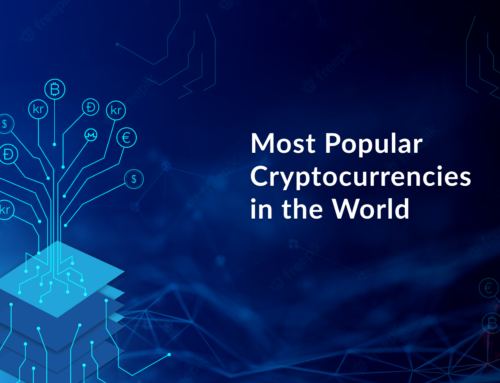According to experts, the complete digital era is still to come, and Bitcoin will be the future currency. All digital assets, including Non-Fungible Tokens (NFT), are currently available in the market and are fast-growing.
Custom blockchain development is the way of the future since it includes all the necessary high-end security features. And each asset will be completely protected by the blockchain.
Healthcare, Finance, Music, Supply chain, logistics, banking, and other industries are utilizing blockchain technology to make corporate processes more transparent and efficient. The three main qualities of blockchain technology that keep it popular are immutability, security, and decentralization.
Any blockchain-based application requires a blockchain framework to be built. There are many platforms for the framework now, and you can learn more about the most common blockchain frameworks here.
The 5 top Blockchain Frameworks for Decentralized Projects
Ethereum
BigchainDB
Corda
Hyperledger Fabric
Hyperledger Sawtooth
The Importance of the Blockchain Framework
The blockchain framework serves as the foundation for any blockchain application. It provides the feature of transparent and immutable record distribution. Everyone who has time-stepped is linked to the previous one. Members of the marketplace can use the features to check the exchanges without having to go between them.
Blockchain technology enables the inspection of every transaction developed across several systems. The listed exchange details cannot be disturbed. The invention of the blockchain allows virtual money to be controlled from a single location rather than multiple apps.
Blockchain technologies make it easier for members to collaborate and build robust applications. Blockchain systems provide a platform for innovators to create and communicate innovative ideas. And by making it easier for designers to get started with blockchain. They also remove roadblocks that prevent engineers from developing blockchain arrangements and applications. Such as the requirement for developer-friendly APIs and development devices.
Let’s have a look at the best blockchain framework on the market to make sure your blockchain-based app is built correctly.
The 5 top blockchain frameworks to watch out for in 2022
- Ethereum
Ethereum is the most well-known, well-established, and oldest blockchain currently available. The very first blockchain development platform is Ethereum. This was the first industry to implement smart contracts in 2015.
The smart contract runs on a specific address in the Ethereum blockchain. It also assists with autonomous accounts on Ethereum and can send transactions and maintain balance. A smart contract is a piece of software that has states and functions.
The Ethereum Virtual Machine (EVM) is a virtual computer that allows Ethereum to operate accounts and smart contracts.
Ethereum Frameworks’ Key Features
- The Ethereum wallet allows the buyer to store and secure ether and other digital assets. The Ethereum wallet also aids in the creation, deployment, and application of smart contracts.
- Smart contracts and Ethereum Apps use the cryptocurrency ether; users might also use Ethereum for virtual organizations.
- Ethereum’s platform can also be used to generate funds without the need for a centralized arbiter or clearinghouse. The Ethereum blockchain framework offers the ability to store funds until a specific date or destination is met. The cash might be returned to the crowd or transferred to the project leader depending on the outcome. The entire procedure is absolutely secure and completely transparent.
- BigchainDB
One of the most popular blockchain frameworks for deploying blockchain-based applications is BigchainDB. It combines decentralized blockchain properties like error-free transactions, immutability, and ownership control. They’re now using tindermint for blockchain functionality and an open-source database for storage.
BigchainDB Frameworks’ Key Features
Fully Decentralized:-
The BigchainDB blockchain system is completely decentralized. It cannot be controlled by a single authority, and each node has its own claim-locally stored list of the access keys of other consortium members.
Immutable Records:-
Anyone attempting to alter data using blockchain technology will be instantly detected. Even if the node becomes corrupted, it is easily traceable and recoverable.
Low Latency: Tendermint conventions are used to finish all communications between hubs, allowing for a large number of trades per second.
Owner Controlled: The owner can design and control their network. The proprietor can build a good-to-go endeavor for the private network with the support of modification and a few approvals.
- Corda
Corda is a business-oriented open-source blockchain extension. It allows you to create interoperable blockchain systems that run safely. Organizations can execute straight with respect thanks to Corda’s smart assertion development. The development firm R3 created Corda. It employs a unique agreement mechanism. In which cryptographically linked exchanges are not grouped in a square on occasion. Corda is described as “both a blockchain and not a blockchain” on its official website. One of the main advantages of this system is that all exchanges are processed in real-time. This is allowing for faster execution than other types of blockchains.
Corda Frameworks’ Key Features
- Only the members with whom it is shared can see the records available on the platform, as Corda delivers the solution from end to end. Other platforms often do not have this capability. Instead, they provide visibility to all available users, but this platform does not. Each Corda node has its own set of records, referred to as a multilateral record.
- Corda separates the contract from the record and the transaction. Because the arrangement does not prepare each transaction and form a consensus on the status of the shared record, the scaling potential is increased.
- Corda employs Intel Software Guard Extensions (SGX) to encrypt and verify records for all parties.
- Hyperledger Fabric
The Hyperledger Fabric is a Hyperledger hub-developed framework. The Linux Foundation established the Hyperledger Hub to build centralized and decentralized blockchain platforms.
The Hyperledger Fabric platform is primarily designed for industries that seek to implement blockchain-based solutions. Because of its modular design and ledgers, the solution is similar to the Ethereum platform. The Hyperledger Fabric feature allows the platform to use a plug-and-play interface. This allows users to choose their services, smart contracts, and agreement algorithm at their leisure.
Hyperledger Fabric’s Key Features
- The Hyperledger Fabric’s blockchain gives users identification from their modular membership service provider. And responsibilities are divided into three categories: 1. The client 2. The peers 3. The Orderer. The clients submit an execution proposal, activate the execution stage, and broadcast transactions and requests. The blockchain ledgers are managed by peers. Orderers who frame the requesting benefits collectively.
- Hyperledger Fabric includes a peer-to-peer communication feature. And that distributes the pieces generated by the requesting feature to all peers.
- Smart contracts don’t work together to get to the record state, and they run in a holding environment to keep them contained.
- Each transaction contains state upgrades, conditions (calculated during execution), and the cryptographic markings of the key supporting peers.
- Hyperledger Sawtooth
The Hyperledger Sawtooth is another open-source blockchain project. Which was facilitated by Hyperledger and the Linux Foundation. Now handled by IBM & Digital Assets, uses a novel agreement component called Confirmation of Passed Time. That can work with hardware-based security advances to authorize “Reliable execution situations” of program code to be executed in a secure enclave with computer memory areas.
Hyperledger Sawtooth is used by ventures to build flexible, robust frameworks and deliver extremely secure blockchain arrangements. Hyperledger Sawtooth, like Fabric and Ethereum, includes a permissioned record type.
Hyperledger Sawtooth is a blockchain platform that allows programmers to create smart contracts in a variety of languages, including Ethereum Virtual Machine, Python, Go, Javascript, and Java, C++.
Hyperledger Sawtooth’s Key Features
- The Raft agreement convention is supported by Hyperledger Sawtooth. RAFT is a crash-tolerant ‘voting’-style agreement calculation designed for high throughput, low idleness exchanges.
- Control records are used by sawtooth hubs to limit who can interact with the arrange and have access to the current record state. Also, transmit agreement messages, take part in the agreement handle, and give the arranged exchanges
- The proof of elapsed time (PoET) consensus calculation is aided by Sawtooth. “At a high level, proof of time elapsed (PoET) stochastically chooses co-workers to process requests at some goal rate,” according to the official Sawtooth description. Peers test an exponentially transmitted arbitrary variable and hold up for a time set by the test. The decision is made by the peer who has the smallest test. A trusted execution environment, personality confirmation, and boycotting based on deviating key cryptography. And an additional set of decision policies are used to prevent cheating.
- PBFT (practical Byzantine fault tolerance) is a voting-based algorithm that uses active network enrollment, normal view modifications, and piece catch-up approach features to vote for agreement among network members.
Additional Bonus:-
Quorum
Quorum is an Ethereum-based open-source blockchain stage. Built in 2016, to serve the fund sector and enable “multiple Ethereum for their high-value blockchain applications.”
Quorum is a customized version of Ethereum spearheaded by the financial services firm JPMorgan. It takes advantage of the Ethereum blockchain stage’s central work and repackages it into a stabilized environment suitable for banks.
It has been optimized to support high-speed interactions between commercial organizations such as banks and security corporations.
It’s similar to Ethereum; the platform’s smart contracts are built in Solidity, which makes switching from Ethereum to Quorum easier. The agreement’s algorithm is usually based on voting on such a platform.
Quorum Blockchain Framework Key Features
- Quorum promotes private transactions and contracts by dividing the state into public and private sectors. For the cooperative exchange of confidential information among network users, it uses peer-to-peer encrypted message swaps (see Star grouping and Tessera).
- Quorum supports peer and node permissions and uses smart contracts to ensure that parties can connect the organization as it was previously understood.
- Ethereum and Bitcoin are substantially slower than the Quorum blockchain. Its basic agreement component can process more than 150 transactions per second. The majority’s IBFT agreement for Byzantine blame resistance and Raft agreement for blame resistance is faster than Ethereum’s verification of work consensus.
So, always consult with experts who can assess the situation and recommend the best solution. Working with different blockchain frameworks allows experienced blockchain developers to quickly determine which platform is most likely to meet the needs.
The blockchain market is evolving at a fast pace. There are always new and more advanced solutions emerging in addition to constant updates to existing ones. When selecting a blockchain development platform for your business, consider both the functionality of the blockchain and its market history. Because proven solutions provide more opportunities for success. To successfully launch a blockchain-based project, you must not only select the right blockchain framework but also find the right development team capable of unleashing the technology’s full potential.
At NetTantra, our experts can help you with both, thanks to their extensive experience and wide range of services. If you are currently looking for a blockchain technology solution, you can read our clients’ reviews or contact us.







Leave A Comment